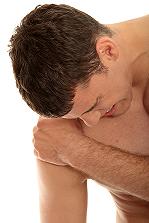A dislocation is an injury caused by physical trauma when the affected bone is displaced or forced from its natural position. Physical traumas such as accidents, falls, collisions and assault normally cause dislocation. Frequent cases of dislocations report injured shoulders, particularly in adults, and affected elbows in children. Sometimes conditions such as rheumatoid arthritis also cause dislocations.
Dislocations often occur in the body’s larger joints; however, smaller joints that are positioned in a way making them vulnerable to dislocation, such as the thumb may get affected by a serious blow in the opposite directions as well. The injury causes the immobilization of your joint, allowing it to swell. You will experience severe pain if you are affected, therefore, you must call emergency medical help promptly so that the affected bone(s) are brought back into their normal positions.
Symptoms
- Swelling
- Severe pain
- Tenderness in the affected region
- The region discolors
- Difficulty in moving the affected bone
Treatment
A dislocation should not be taken lightly and it is critical that you seek medical attention immediately. Till help arrives, follow these steps:
1. Do not move the joint or try to force it back to its position
Until help arrives, you may secure the affected joint but not move it. Moving the bone may cause further damage to the muscles, nerves, blood vessels and ligaments in the affected area and aggravate the situation even more.

2. Apply ice packs on the affected joint
This will reduce swelling and keep internal bleeding under control to preclude fluid discharge inside and around the affected joint.
3. Further treatment till help arrives:
- If there are any cuts, apply pressure on the wounds to stop bleeding and wrap the wound with a sterile gauze or bandage.
- If the person is unconscious, check for signs of circulation such as breathing, movement or coughing. If the person is not breathing, begin CPR till help arrives.
- Elevate the feet up to heart level to encourage circulation with gravity.
- Reassure the patient and cover him with a blanket.
Prevention
- Make your house safe for the children.
- Wear protective gear while indulging in sports activities.
- Teach your children safety precautions such as not jumping off of heights, standing on chairs etc.
- If the floor is slippery, do not walk on it.
- Take care while using bath oils.
- Use the hand rails while you climb stairs.
- Do not run on land that is smooth or slippery. Do not run down the stairs.
Additional Training
To learn more about bone and skeletal injuries, including dislocations, take a St Mark James training course with a provider near you. A list of premier training locations can be found on our “locations” page. Training partners are located in Vancouver, Toronto, Windsor, Red Deer, Edmonton, Saskatoon, Calgary, Winnipeg and Halifax.
Related Video on Dislocations
